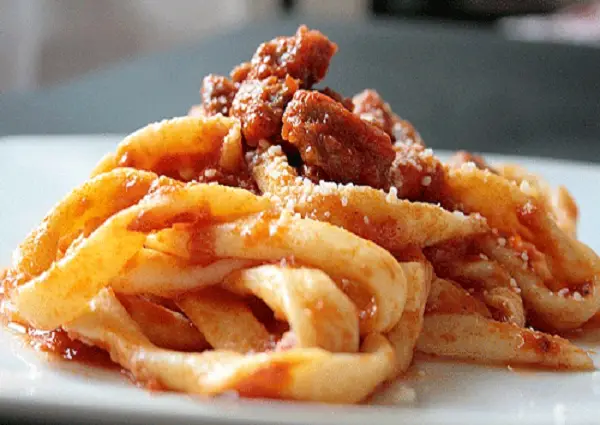Maccheroni alla molinara
Maccheroni alla molinara
Ingredients
Servings: 8 – 10
For the ragu
-
3 tablespoons vegetable oil or olive oil
-
6 ounces boneless beef chuck roast, cut into 4 equal pieces
-
6 ounces boneless lamb shoulder, cut into 3 equal pieces
-
Kosher or fine sea salt
-
Freshly ground black pepper
-
3 pounds whole or diced canned tomatoes (about 7 1/2 cups)
-
2 tablespoons extra-virgin olive oil
-
1 yellow onion, chopped
-
Water (optional)
For the pasta dough
-
5 to 6 cups flour, plus more for dusting the work surface
-
2 extra-large eggs
-
3/4 to 1 cup tepid water
For serving
-
Freshly grated Parmigiano-Reggiano cheese
Directions
For the ragu:
-
Heat the vegetable or olive oil in a large Dutch oven or other heavy-bottomed pot over medium heat. Season the pieces of meat with a little salt and pepper and add them to the pot. Brown for 3 to 4 minutes, then turn the pieces to brown the other side, another 3 to 4 minutes. Transfer the pieces to a deep plate or bowl.
-
Pass the tomatoes through a food mill fitted with a disk with the smallest holes, letting the strained tomatoes fall into a large bowl. Discard the solids left in the food mill.
-
Return the pot to medium heat and add the extra-virgin olive oil. Stir in the onion; reduce the heat to medium-low and cook for about 5 minutes or until the onion is shiny and beginning to soften. Pour in the strained tomatoes; increase the heat to medium-high. Once the tomatoes start to bubble, return the meat to the pot. Reduce the heat to medium-low or low to maintain gentle bubbling. Cover partially and cook for about 3 hours, stirring from time to time, until the meat is very tender and a thickened ragu has formed. Add a splash or two of water if the sauce thickens too much before the meat is done. Taste; add salt and pepper as needed.
-
Turn off the heat. Remove the meat from the pot before using the ragu; reserve for another use, if desired. The yield of the smooth ragu is about 6 cups. If using right away, keep warm.
To make the pasta dough:
-
Pile 5 cups of the flour into a mound on a clean work surface. Make a well in the center of the mound and break the eggs into it. With a fork, break the egg yolks and begin to work in the flour from the inside wall of the well. Then start pouring 3/4 cup of the tepid water, a little at a time, into the well and continue to work the flour into the egg mixture until it has a batter-like consistency. Work carefully so that you don’t break the wall of flour, which would allow the egg mixture to run out and make things messy. (If that happens, don’t panic; use the palm of your hand to scoop up the escaped liquid and work it back toward the flour.)
-
Use your hands to draw the remaining flour over the thickened egg mixture and mix until you have a soft dough. As you work, you will determine whether you need to add more flour to prevent the dough from being sticky or more water to moisten it if it seems dry. You are aiming for a fairly pliable dough that you can knead easily.
-
Then, knead the dough: Using the palm of your hand, push the dough gently but firmly away from you and then fold it over toward you. Rotate the dough a quarter-turn and repeat the pushing and folding motion. Continue kneading for several minutes or until the dough is smooth and silky. Form the dough into a ball, cover it with an overturned bowl and let it rest for about 20 minutes. Then knead it once more for several minutes, re-cover it and let it rest for 5 to 10 minutes. The second kneading and resting are essential to achieve the light dough necessary for this unique, thick noodle.
-
Cover a large space with a clean tablecloth and sprinkle the cloth with flour. This is where you will put the pasta once it is shaped. Cut the dough into 4 equal pieces. Form each piece into a round, slightly flattened bun. Cover 3 of the pieces with a clean dish towel.
-
Lightly flour a work surface.
-
Flatten the remaining bun into a thick disk. Pick it up and use your finger to poke a hole through the center. Working a couple of fingers into the hole, begin to stretch the pierced disk into a fat ring, like a bagel. Gently stretch the ring until it is large enough for you to fit both hands through it: 6 to 8 inches wide in the center.
-
Begin to roll the ring into an even, ever-growing loop on the lightly floured work surface. Your aim is to end up with a very long loop about the thickness of your pinkie finger, always working carefully so you don’t break the circle. Take your time working your way around the loop as it grows longer, keeping the thickness more or less uniform. When you finish, the loop will be very long and rather unwieldy. Pick up the loop with one hand, and with your other hand start wrapping it into a loose coil, as you would a rope. Sprinkle a small mound of flour on your work surface and carefully coat the coil with the flour to prevent it from sticking. Pick up the coil and gently grasp and pull it to stretch it; not too much, just several rotations, to lengthen the coil further. Coat it once more with flour and place it on the floured cloth.
-
In the same way, shape each of the remaining buns of dough into long loops and wind them into coils. Cover the coils with clean dish towels until it is time to cook them. (Because of its unique shape and thickness, this pasta is best cooked soon after it is made, though it can be shaped and stored in the freezer for several hours before cooking. To freeze, carefully transfer the coiled noodles to a rimmed baking sheet/tray liberally dusted with flour; to cook them, transfer the coils directly from the freezer to boiling water.
-
Bring a very large pot or a stockpot of water to a rolling boil over high heat. Salt generously.
-
Carefully lift up a coil and let it fall into the water. It will start to unravel. Carefully add the remaining coils and use a large wooden or metal serving fork to stir the noodles. Some of the loops will eventually break apart as they cook; that is okay. Cover the pot until the water returns to a boil, then uncover and cook the pasta for 15 to 20 minutes, gently swirling it around once or twice, until it is al dente.
-
When the pasta is almost cooked, warm a very large serving bowl.
-
Spoon about two-thirds of the heated ragu into the bowl. Once the pasta is ready, use a very large skimmer or the serving fork to carefully lift the cooked noodles out of the water. Let them drain for a second or so and then transfer them to the serving bowl. Continue to lift and transfer the noodles until you have removed them all from the water.
-
Spoon the remaining ragu (or as much as desired) on top of the noodles; toss gently but thoroughly until the pasta is evenly coated. Serve immediately, with Parmigiano-Reggiano passed at the table.
This site contains product affiliate links. We may receive a commission if you make a purchase after clicking on one of these links.



